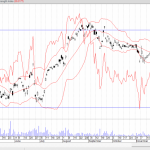“The equity market continue to float on a cloud of who knows what”. | “This is not like any market anyone alive has seen before.” | “There is no euphoria, which is usually not a sign of a market peak.” | “There is enough pessimism for the market to continue climbing higher.” | “The engine seems to be running, but no one has bothered to look under the hood.” — These are just some of the comments I have heard from portfolio managers in the past month.
This month I want to discuss the topic of value. Value is a term that means different things to different people. Frequently. people use the term to describe investments that are “cheap”. Of course, “cheap” also means different things to different people.
Take for example a bar of chocolate. 100 years ago you could buy chocolate for $0.03 per oz. Today you are paying close to $0.50 per oz. for the same chocolate. Has anything changed? Did you get a better deal 100 years ago? Of course inflation plays a part in this simple equation, but this simple equation makes the point that prices relate to other things which you use to justify whether something is cheap or expensive. (I used chocolate because it has a historical tendency to correlate to inflation.)
Now, lets look at today’s equity and bond prices.
Bonds
Today, we are at an interesting point in time. We have had a historic bond bull market for the past 36 years. Rates peaked in 1981 and have dropped ever since (bottoming out last year). So if you think bonds are safe, think again. Your recency bias makes you think bonds are safe because you have experienced nothing but rising prices (plus interest) from bonds for 36 years.
The same recency bias also makes you believe that positive inflation is normal and constant, but I digress?…
Bonds are actually extremely risky right now, if you don’t know what you are doing. ?Not only are interest rates still historically low, but they are rising. This is great if you are looking for more interest, but bad if you are holding bonds which are declining in price.
So are bonds cheap or expensive??
Well, if you compare US bond yields to global yields, the US is cheap (i.e. yields in the US are higher than other countries). However, if you compare the US yields to their own historical yields, bonds are still very expensive.? I am simplifying this quite a bit to provide you with some context.
Generally speaking, bonds are expensive. If you are retired or close to retirement, this is a problem. You need income and you cannot find many low-risk income sources with a high enough yield enough to live off of. Think about it this way. It was not long ago that you could get 5% on fixed income investments that were not risky. This means if you have $1,000,000, you could live off of $50,000 a year in income. However, today that same $1,000,000 would yield $15,000 a year in income. If you add in inflation, you have even less in spending power.
So are bonds expensive? YES.?
Stocks
Now, let’s look at stock prices…
Stocks are also subject to the same judgement of value. ?
Are they cheap or expensive?
It depends on who you ask. Here is a chart that will give you an idea of what I mean.

?Here are 20 different ways to look at the valuation of the equity markets. I’m sure I could come up with more than 20, but it should give you an idea of how complex the idea of valuation is.
If you have watched CNBC in the past few years you are probably equally confused about whether stocks are cheap or expensive. Anyone can pick out a metric and say that this is the reason stocks are expensive or cheap.? There is no singular way to measure value other than experience and judgement.
Let me give you an example. If you look at stocks today, most people would say they are expensive.? However, compared to 1999, they are cheap. In 1999, they were extremely overpriced, so it is a bad comparison, but people in the media today are comparing stocks to 1999 valuations.
What you should note is the situations are very different. In 1999, interest rates were around 6%. Today they are around 2.25%. If you are not well versed in how interest rates affect other investments, there is a concept of what is called the “risk-free rate of return”. This is a theoretical rate of return that has no risk (it is theoretical because riskless investments doesn’t exist). Markets traditionally use the 3-month Treasury Bill yield as the risk-free rate of return because this is the closest thing to a risk-free investment that exists.
The risk-free rate of return is important because when you look to invest your money, you should compare any investment to this risk-free rate of return.? You should ask yourself, is the increased risk worth the return you would get from from the investment.














Leave A Comment